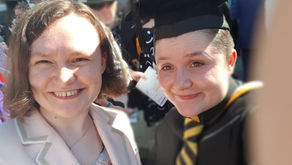Week 5- Thoughts on Ideas
- Tramaine Berry
- Oct 24, 2020
- 7 min read
Updated: Sep 21, 2023
RESEARCH //

After listening to this lecture, I looked into how music effects the brain because as a dyslexic I find it easier to process information and maintained focused with music in the background. Turns out that music activates both the left and right hemispheres, maximising learning and memory. Additionally, music can elevate the mood, which according to Shelley Carson activates the 'connection brain set'. The connection brainset is a state of divergent thinking where you can generate multiple solutions to a problem by making connections between remotely associated bits of information. It can broaden an individul's attention and allows you to think creatively. Although, Dr Neil McLatchie of Lancaster University believes that music has the opposite effects for creatives (See quote below).
“To conclude, the findings here challenge the popular view that music enhances creativity, and instead demonstrate that music, regardless of the presence of semantic content (no lyrics, familiar lyrics or unfamiliar lyrics), consistently disrupts creative performance in insight problem-solving.”
Listening to the thinking hats process, I was reminded of the Design Dice, which was introduced to me by my second year tutor, Andy Neal. Andy Neal is a Graphic Design tutor at Falmouth University and has designed a set of dice that aim to kickstart the creative process during crative blocks. Sticky notes are recommended when doing these exercises for better flow of ideas.

The Red Dice is for discovery- mapping out possibilities, themes and context.
The Green Dice is for developing ideas- pushing a single thought into multipl sections.
The Blue Dice is for visually crafting your ideas
The Black Dice is for strategy & project managagement.
The Yellow Dice is for time for you to complete the task. This dice is usually paired with other dice.
This process is very similar to the Double Diamond approach because both involve Discovery (black dice), Define (red dice), Develop (Green Dice) and Deliver (blue dice), so the Design Dice can collaborate with this process for better creative flow.
The Double Diamond Approach was developed by the British Design Council in 2005 with the aim to promote divergent and convergent thinking. The purpose of this process is to show that no idea is ever finished because sometimes you have to start from the beginning or go back a step.

Guest Lecture with Daniel Eatock
Daniel Eatlock specialises in lateral thinking through responding to and embracing everyday life. I find the way he transforms negative energy into a creative piece very intriguing because it acts as a form of therapy. Shelly Carson describes as the 'Transform brain set', which is a state of inner focus and transforms negative emotions into creative output.
Below is a video of Eatock using the car alarm (the cause of his negative energy) to channel his energy into a dance.


The image above is my response to the lecture. As I was trying to study, my neighbour was hammering something, so I dabbed acrylic paint on the end of a hammer and hit the paper several times. I felt a lot better afterwards, although somewhat guilty halfway through this process due to the fact that I have flatmates working from home. It also reminded me of a therapy proces I went through at a young age, which involved painting aggressively onto a pillow and then using it as a punching pillow.
To mimic Eatock's idea of transformation, I have used this piece as a base for a creative artwork, which have been digitally manipulated. Below is a art puzzle created by Eatock, which I have also used to inspire a couple of pieces by cutting up the work I have done and rearranging.





Dr. Shelley Carson- 7 Brain-sets
Dr. Sheeley Carson specialises in psychopathology and creativity. In the TedTalk 'The quick start guide to creativity', she talks about her research inspired by her book ' Your Creative Brain: Seven Steps to Maximize Imagination', which provides us with information on the different stages for a creative process.

This TedTalk reminded me of the minimalist movement due to how it provents us from noticing the fine details in everyday life, which is important to activate the 'state brain set.
One interesting article I found talked about how minimalist buildings have a negative influence on our mood, which can disrupt our state of divergent thinking (connect brain-set). The 33 apartment blocks below were designed by Minoru Yamasaki, which became famous for its crime, squalour and social dysfunction, and the open spaces between the buildings discouraged a sense of community.
In contrast, I refer to Speikerman's studio design referenced in 'Studio Culture', which is designed to elevate social interaction. Collin Ellard says the complexity of a building affecs people in a positive way.


Additionally, cities like Vancouver have design and building policies that accomodate nearby natural greenery, which increases the awareness of our environment through loosening the filters known as cognitive disinhibition, activating a gateway towards new ideas and experiences (absorb brain-set). However, it does make me wonder how the 'transfom' brain-set is activated if there is less negative energy within the designer's working enviroment to inspire pieces of work like Daniel Eatock has. This also reminds me of the 'slow city movement' and how green spaces have been added to increase well-being and creativity (See chapter 'slow movement' for more information).
Cognitive psychology:connecting mind, research and everyday experience by E. Bruce Goldstein. 2015


I am very interested in how sensory memory influences the creative process. According to Dr. Art Markman, the only route to finding creative solutions to a problem is to find information in your memory that will help you to solve the problem in some way. By my understanding memory is influenced by stress, so if an individual was in a stressful enviroment such as the minimalist buildings designed by Minoru Yamasaki (previous chapter), then it is likely the individual will go through creative blocks.


Slow Movement




This video explores how the quality of life, well-being and creativity can be improved by applying the principles of slow. The video refers to project 'Slow Down London, 2009', which aims to inspire Londoners to improve their lives by slowing down. This involved an exploration of slow music and art, meditation and yoga, slow food and crafts, and slow travel.
WORKSHOP CHALLENGE //
I have decided to base the creative process on the '7 Slow Design Principles' because I think it is the first step towards the creative process. Slowing down decreases stress, which improves our memories and enables us to reference them for the idea generation process.
Additionally, the slow movement embraces the idea of surrounding ourselves in natural enviroments, which loosens the filters refered to as cognitive disinhibition and actives three of the seven C.R.E.A.T.E.S brainsets (Absorb, Connect and Stream).



This was a basic diagram of the main stages I wanted to communicate.

It was only after I went over my research once more that I started to question whether memory and idea generation have a connection.

I changed the psychology of the diagram by placing more emphasis on the 'CREATE' brain-set because the idea of the slow movement is only a trigger rather than a creative process; Dr. Shelley Carson recommended meditation and nature in order to activate a few of the brain-sets. And although she didn't mention 'slow movement' within her TedTalk, her research led me to explore how surroundings affected this process.
I placed more emphasis on the CREATE process by representing each of the seven brain-sets within the diagram rather than placing them in a generalised group; I realise that these brainsets happen at different stages of the creative process. So the diagram above is me figuring out where they all fit within this process.
Additonally, Dr. Carson mentions how important it is to elevate the mood, which allowed me to explore how stress can have a negative effect on memory and as a result create creative blocks.
I also wanted to explain how natural stimuli activates these brain sets by loosening the cognitive filters known as cognitive disinhibition.

I decided to make 'transform' directly after natural stimuli becasue I realised that decreasing stress comes after transform rather than after, but I also added 'decrease stress' directly after nature to show that 'transform' is an option in this process (although recommended for mental illness).
I corrected Absorb and Stream after realising how loosening the filters is more of an after-effect of the Absorb state, and you need to be in the zone (steam state) in order t be able to create a memory.
And Connect refers to the gathering of information, which I added as the last process towards idea generation. Evaluate and reason are placed after generation, referring back and forth to each other in the creative process.
I forgot to add the 'Envision' brain-set, which should be after Sensory memory and before Connect.
Feedback


DISCUSSION //

REFLECTION //
This week I've enjoyed learning about how our environment influences our creative process.
As a dyslexic, I've always had problems with absorbing and processing information, which influences the speed of my idea generation and regular creative blocks. Now that I know memory is associated with stress and exposure to stimulating enviroments, I need to encourage myself to get outside the house as well as embracing the slowness rather than getting frustrated with myself.
I think my research journey for the workshop only started with the guest lecture because I was amazed with how he reacted to his enviroment and was able to recognise his process easily through the research I had already achieved. If I were to do this workshop again, I would have looked more into more variations of design processes rather than fixating on psychological well-being; however, it is something I am very passionate about, so I am glad I managed to combine process and well-being together.
RESOURCES //
Dr Neil McLatchie of Lancaster University https://onlinelibrary.wiley.com/doi/full/10.1002/acp.3532
Shelley Carson: https://youtu.be/lHf_jUmtR70
Daniel Eatock: https://youtu.be/2nBKNV1zMmQ https://www.instagram.com/p/CFJvCslhfo4/
Architecture and psychology: https://www.bbc.com/future/article/20170605-the-psychology-behind-your-citys-design
Studio Culture: the Secret Life of the Graphic Design Studio
Cognitive psychology: connecting mind, research and everyday experience by E. Bruce Goldstein. 2015
https://www.bbc.com/future/article/20170605-the-psychology-behind-your-citys-design
https://www.reclaimedflooringco.com/the-6-principles-of-slow-design/
https://www.researchgate.net/publication/262313813_Slow_Design_for_meaningful_interactions
http://imgongyu.blogspot.com/2010/05/recycled-soundscapes.html
https://medium.com/designing-atlassian/slow-design-9edd781c7f92
Tylerrai, performance artist on slow movement: https://www.tylerrai.com/artist-statement https://www.slowlab.net/Encounter-IMMERSIVE-STUDY-EXPERIENCES
In praise of slowness, Carl Honore. 2005. https://www.ted.com/talks/carl_honore_in_praise_of_slowness?utm_campaign=tedspread&utm_medium=referral&utm_source=tedcomshare
The Slow Revolution by Carl Honore, Gervais Williams, Deepa Patel and Kate Fletcher. Ted Talk, 2012. https://youtu.be/uyv8eFHbsvk
Slow Down London: https://www.mashstaffing.com/uk/slow-down-london/













Comments